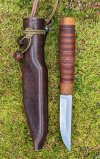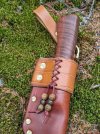ron55
Gold Member
- Joined
- Sep 2, 2022
- Messages
- 480
Thanks!Sorry took so long to get back. I'd thought I'd answered this and then was rereading and realized I hadn't. Look at Leather Wranglers and Knipshield Leather tools. I don't have any experience with these personally but have heard good things.
7/8 oz will handle most fixed blade chores and is probably the most common leather weight used in sheath making. I do use lighter for some specific things and heavier for a lot. I think the quality of the leather is more important than the weight. Most pros will use either Wicket and Craig or Herman Oak veg tan leather.



